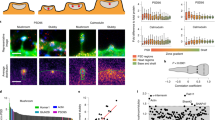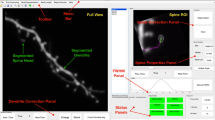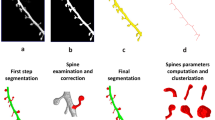Abstract
Morphological features such as size, shape and density of dendritic spines have been shown to reflect important synaptic functional attributes and potential for plasticity. Here we describe in detail a protocol for obtaining detailed morphometric analysis of spines using microinjection of fluorescent dyes, high-resolution confocal microscopy, deconvolution and image analysis with NeuronStudio. Recent technical advancements include better preservation of tissue, resulting in prolonged ability to microinject, and algorithmic improvements that compensate for the residual z-smear inherent in all optical imaging. Confocal imaging parameters were probed systematically to identify both optimal resolution and the highest efficiency. When combined, our methods yield size and density measurements comparable to serial section transmission electron microscopy in a fraction of the time. An experiment containing three experimental groups with eight subjects each can take as little as 1 month if optimized for speed, or approximately 4–5 months if the highest resolution and morphometric detail is sought.
This is a preview of subscription content, access via your institution
Access options
Subscribe to this journal
Receive 12 print issues and online access
$259.00 per year
only $21.58 per issue
Buy this article
- Purchase on Springer Link
- Instant access to full article PDF
Prices may be subject to local taxes which are calculated during checkout








Similar content being viewed by others
References
Bhatt, D.H., Zhang, S. & Gan, W.B. Dendritic spine dynamics. Annu. Rev. Physiol. 71, 261–282 (2009).
Kasai, H., Fukuda, M., Watanabe, S., Hayashi-Takagi, A. & Noguchi, J. Structural dynamics of dendritic spines in memory and cognition. Trends Neurosci. 33, 121–129 (2010).
Alvarez, V.A. & Sabatini, B.L. Anatomical and physiological plasticity of dendritic spines. Annu. Rev. Neurosci. 30, 79–97 (2007).
Bourne, J. & Harris, K.M. Do thin spines learn to be mushroom spines that remember? Curr. Opin. Neurobiol. 17, 381–386 (2007).
Sorra, K.E. & Harris, K.M. Overview on the structure, composition, function, development, and plasticity of hippocampal dendritic spines. Hippocampus 10, 501–511 (2000).
Nimchinsky, E.A., Sabatini, B.L. & Svoboda, K. Structure and function of dendritic spines. Annu. Rev. Physiol. 64, 313–353 (2002).
Yuste, R. & Bonhoeffer, T. Genesis of dendritic spines: insights from ultrastructural and imaging studies. Nat. Rev. Neurosci. 5, 24–34 (2004).
Garcia-Lopez, P., Garcia-Marin, V. & Freire, M. The discovery of dendritic spines by Cajal in 1888 and its relevance in the present neuroscience. Prog. Neurobiol. 83, 110–130 (2007).
de Lima, A.D., Voigt, T. & Morrison, J.H. Morphology of the cells within the inferior temporal gyrus that project to the prefrontal cortex in the macaque monkey. J. Comp. Neurol. 296, 159–172 (1990).
Nimchinsky, E.A., Hof, P.R., Young, W.G. & Morrison, J.H. Neurochemical, morphologic, and laminar characterization of cortical projection neurons in the cingulate motor areas of the macaque monkey. J. Comp. Neurol. 374, 136–160 (1996).
Duan, H., Wearne, S.L., Morrison, J.H. & Hof, P.R. Quantitative analysis of the dendritic morphology of corticocortical projection neurons in the macaque monkey association cortex. Neuroscience 114, 349–359 (2002).
Duan, H. et al. Age-related dendritic and spine changes in corticocortically projecting neurons in macaque monkeys. Cereb. Cortex 13, 950–961 (2003).
Radley, J.J. et al. Repeated stress induces dendritic spine loss in the rat medial prefrontal cortex. Cereb. Cortex 16, 313–320 (2006).
Hao, J. et al. Estrogen alters spine number and morphology in prefrontal cortex of aged female rhesus monkeys. J. Neurosci. 26, 2571–2578 (2006).
Hao, J. et al. Interactive effects of age and estrogen on cognition and pyramidal neurons in monkey prefrontal cortex. Proc. Natl. Acad. Sci. USA 104, 11465–11470 (2007).
Radley, J.J. et al. Repeated stress alters dendritic spine morphology in the rat medial prefrontal cortex. J. Comp. Neurol. 507, 1141–1150 (2008).
Dumitriu, D. et al. Selective changes in thin spine density and morphology in monkey prefrontal cortex correlate with aging-related cognitive impairment. J. Neurosci. 30, 7507–7515 (2010).
Yang, G., Pan, F. & Gan, W.B. Stably maintained dendritic spines are associated with lifelong memories. Nature 462, 920–924 (2009).
Russo, S.J. et al. The addicted synapse: mechanisms of synaptic and structural plasticity in nucleus accumbens. Trends Neurosci. 33, 267–276 (2010).
LaPlant, Q. et al. Dnmt3a regulates emotional behavior and spine plasticity in the nucleus accumbens. Nat. Neurosci. 13, 1137–1143 (2010).
Christoffel, D. et al. IkappaB kinase regulates social defeat stress induced synaptic and behavioral plasticity. J. Neurosci. 31, 314–321 (2011).
Vecellio, M., Schwaller, B., Meyer, M., Hunziker, W. & Celio, M.R. Alterations in Purkinje cell spines of calbindin D-28 k and parvalbumin knock-out mice. Eur. J. Neurosci. 12, 945–954 (2000).
Wallace, W. & Bear, M.F. A morphological correlate of synaptic scaling in visual cortex. J. Neurosci. 24, 6928–6938 (2004).
Knafo, S. et al. Widespread changes in dendritic spines in a model of Alzheimer's disease. Cereb. Cortex 19, 586–592 (2009).
Knafo, S. et al. Morphological alterations to neurons of the amygdala and impaired fear conditioning in a transgenic mouse model of Alzheimer's disease. J. Pathol. 219, 41–51 (2009).
Merino-Serrais, P., Knafo, S., Alonso-Nanclares, L., Fernaud-Espinosa, I. & Defelipe, J. Layer-specific alterations to CA1 dendritic spines in a mouse model of Alzheimer's disease. Hippocampus published online, doi:10.1002/hipo.20861 (16 September 2010).
Rodriguez, A., Ehlenberger, D.B., Hof, P.R. & Wearne, S.L. Rayburst sampling, an algorithm for automated three-dimensional shape analysis from laser scanning microscopy images. Nat. Protoc. 1, 2152–2161 (2006).
Rodriguez, A., Ehlenberger, D.B., Dickstein, D.L., Hof, P.R. & Wearne, S.L. Automated three-dimensional detection and shape classification of dendritic spines from fluorescence microscopy images. PLoS One 3, e1997 (2008).
Russo, S.J. et al. Nuclear factor kappa B signaling regulates neuronal morphology and cocaine reward. J. Neurosci. 29, 3529–3537 (2009).
Shen, H., Sesack, S.R., Toda, S. & Kalivas, P.W. Automated quantification of dendritic spine density and spine head diameter in medium spiny neurons of the nucleus accumbens. Brain Struct. Funct. 213, 149–157 (2008).
Zhang, Y. et al. A neurocomputational method for fully automated 3D dendritic spine detection and segmentation of medium-sized spiny neurons. Neuroimage 50, 1472–1484 (2010).
Kim, Y. et al. Phosphorylation of WAVE1 regulates actin polymerization and dendritic spine morphology. Nature 442, 814–817 (2006).
Shansky, R.M., Hamo, C., Hof, P.R., McEwen, B.S. & Morrison, J.H. Stress-induced dendritic remodeling in the prefrontal cortex is circuit specific. Cereb. Cortex 19, 2479–2484 (2009).
Huang, B., Babcock, H. & Zhuang, X. Breaking the diffraction barrier: super-resolution imaging of cells. Cell 143, 1047–1058 (2010).
Blom, H. et al. Spatial distribution of Na+-K+-ATPase in dendritic spines dissected by nanoscale superresolution STED microscopy. BMC Neurosci. 12, 16 (2011).
Donohue, D.E. & Ascoli, G.A. Automated reconstruction of neuronal morphology: an overview. Brain Res. Rev. 67, 94–102 (2010).
Chklovskii, D.B., Vitaladevuni, S. & Scheffer, L.K. Semi-automated reconstruction of neural circuits using electron microscopy. Curr. Opin. Neurobiol. 20, 667–675 (2010).
Arellano, J.I., Espinosa, A., Fairen, A., Yuste, R. & DeFelipe, J. Non-synaptic dendritic spines in neocortex. Neuroscience 145, 464–469 (2007).
Nusser, Z. AMPA and NMDA receptors: similarities and differences in their synaptic distribution. Curr. Opin. Neurobiol. 10, 337–341 (2000).
Matsuzaki, M. et al. Dendritic spine geometry is critical for AMPA receptor expression in hippocampal CA1 pyramidal neurons. Nat. Neurosci. 4, 1086–1092 (2001).
Kopec, C. & Malinow, R. Neuroscience. Matters of size. Science 314, 1554–1555 (2006).
Ostroff, L.E., Cain, C.K., Bedont, J., Monfils, M.H. & Ledoux, J.E. Fear and safety learning differentially affect synapse size and dendritic translation in the lateral amygdala. Proc. Natl. Acad. Sci. USA 107, 9418–9423 (2010).
Harris, K.M. & Stevens, J.K. Dendritic spines of CA 1 pyramidal cells in the rat hippocampus: serial electron microscopy with reference to their biophysical characteristics. J. Neurosci. 9, 2982–2997 (1989).
Harris, K.M., Jensen, F.E. & Tsao, B. Three-dimensional structure of dendritic spines and synapses in rat hippocampus (CA1) at postnatal day 15 and adult ages: implications for the maturation of synaptic physiology and long-term potentiation. J. Neurosci. 12, 2685–2705 (1992).
Mishchenko, Y. et al. Ultrastructural analysis of hippocampal neuropil from the connectomics perspective. Neuron 67, 1009–1020 (2010).
Katz, Y. et al. Synapse distribution suggests a two-stage model of dendritic integration in CA1 pyramidal neurons. Neuron 63, 171–177 (2009).
Megias, M., Emri, Z., Freund, T.F. & Gulyas, A.I. Total number and distribution of inhibitory and excitatory synapses on hippocampal CA1 pyramidal cells. Neuroscience 102, 527–540 (2001).
Schikorski, T. & Stevens, C.F. Quantitative ultrastructural analysis of hippocampal excitatory synapses. J. Neurosci. 17, 5858–5867 (1997).
Pawley, J.B. ed. Handbook of Biological Confocal Microscopy 3rd edn (Springer Science+Business Media, 2006).
Harris, K.M. & Kater, S.B. Dendritic spines: cellular specializations imparting both stability and flexibility to synaptic function. Annu. Rev. Neurosci. 17, 341–371 (1994).
Murray, J.M. Practical aspects of quantitative confocal microscopy. Methods Cell Biol. 81, 467–478 (2007).
Diaz-Zamboni, J.E. et al. 3D automatic quantification applied to optically sectioned images to improve microscopy analysis. Eur. J. Histochem. 52, 115–126 (2008).
Acknowledgements
This work was supported by NIA grants AG006647 (J.H.M.) and AG010606 to (J.H.M.) and NRSA training grant 1F30MH083402 (D.D.). We also acknowledge the late S. Wearne and P.R. Hof for the development of NeuronStudio, funded by US National Institutes of Health grants AG035071 and MH071818. We thank B. Janssen, Y. Grossman, R. Gonzaga and N. Dumitriu for technical assistance. We thank B. Janssen, E. Bloss and Q. Laplant for helpful suggestions on the manuscript. We are also deeply grateful to T. Hu and D. Chklovskii for their computational assistance with exponential decay curve fitting.
Author information
Authors and Affiliations
Contributions
All authors contributed to the preparation of the manuscript. D.D. conducted all experiments, made the figures and wrote the initial draft of the manuscript. A.R. programmed the z-smear correction factor into NeuronStudio. J.H.M. provided guidance throughout the experimental phase and improved the manuscript.
Corresponding author
Ethics declarations
Competing interests
The authors declare no competing financial interests.
Supplementary information
Supplementary Fig. 1
Z-projections of the 23 dendrites used in the morphometric analysis of dendritic spines in the stratum radiatum of the male rat CA1. The 4-6 segments from each of the 5 animals included in the analysis are each boxed in a separate color. Note the diversity in spine density, spine size and dendritic diameter. Segments A2i and A2ii are the same as the examples shown in Figure 7A. Scale bar = 5µm. (TIFF 4122 kb)
Rights and permissions
About this article
Cite this article
Dumitriu, D., Rodriguez, A. & Morrison, J. High-throughput, detailed, cell-specific neuroanatomy of dendritic spines using microinjection and confocal microscopy. Nat Protoc 6, 1391–1411 (2011). https://doi.org/10.1038/nprot.2011.389
Published:
Issue Date:
DOI: https://doi.org/10.1038/nprot.2011.389
This article is cited by
-
Activation of prefrontal parvalbumin interneurons ameliorates working memory deficit even under clinically comparable antipsychotic treatment in a mouse model of schizophrenia
Neuropsychopharmacology (2024)
-
α-MSH-catabolic enzyme prolylcarboxypeptidase in nucleus accumbens shell ameliorates stress susceptibility in mice through regulating synaptic plasticity
Acta Pharmacologica Sinica (2023)
-
Genome-wide meta-analysis, functional genomics and integrative analyses implicate new risk genes and therapeutic targets for anxiety disorders
Nature Human Behaviour (2023)
-
Two opposing hippocampus to prefrontal cortex pathways for the control of approach and avoidance behaviour
Nature Communications (2022)
-
Structure and function differences in the prelimbic cortex to basolateral amygdala circuit mediate trait vulnerability in a novel model of acute social defeat stress in male mice
Neuropsychopharmacology (2022)
Comments
By submitting a comment you agree to abide by our Terms and Community Guidelines. If you find something abusive or that does not comply with our terms or guidelines please flag it as inappropriate.



